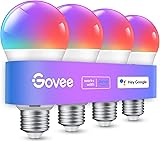As an Amazon Associate, we may earn a commission if you make a purchase — at no extra cost to you.
Philips Hue vs LIFX: Smart Lighting Comparison for Your Home
If you’re looking at smart lighting, Philips Hue and LIFX are probably the two brands you’ve heard about most. Both let you change colors and have some pretty advanced features, but their systems aren’t built the same way. Philips Hue uses its Hue Bridge hub for control, while LIFX bulbs skip the hub and just connect straight to your Wi-Fi. If price is a big factor, TP-Link Kasa smart bulbs might also be worth a look.
Table of Contents
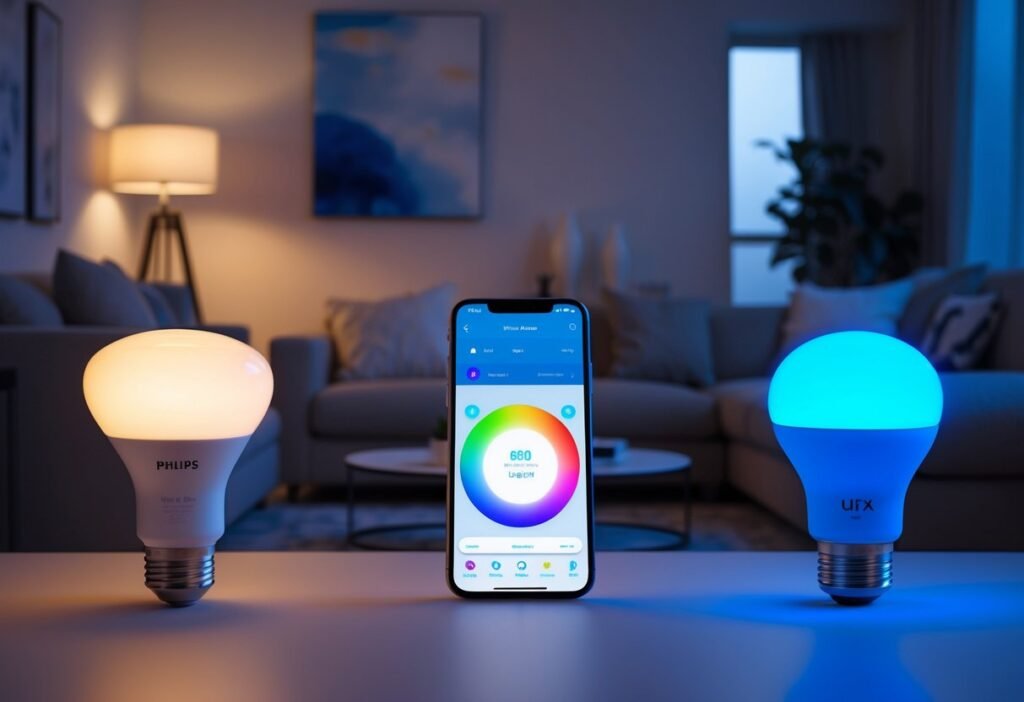
Deciding between Philips Hue and LIFX really comes down to what you care about—ease of use, compatibility, or just how good the lights look. Hue is famous for playing nicely with lots of smart home stuff, while LIFX bulbs are all about brightness and color punch. Let’s dig into the main differences, features, and value so you can figure out what’s best for your space.
- Works with Amazon Alexa to support dimming, shades of white, and color settings through voice…
- 16 million colors and warm to cool whites. LED life-span – 22.8 years (based on 3hrs/day)
- Easy to set up, built in wifi – no hub required
Last update on 2025-07-15 / Affiliate links / Images from Amazon Product Advertising API
- WHAT’S IN THE BOX – Includes one soft warm white smart 75W-equivalent A19 light bulb; Perfect for…
- UNLOCK THE FULL POWER OF HUE – Add a Hue Bridge to enjoy automations, control from anywhere in the…
- SOFT WHITE LIGHT – Enjoy dimmable, soft white light in your home that allows you to easily set the…
Last update on 2025-07-15 / Affiliate links / Images from Amazon Product Advertising API
Key Takeaways
- Philips Hue and LIFX handle connections and ecosystems differently.
- Quality of light and smart features aren’t identical across brands.
- The right choice depends on your setup and what you want out of smart lighting.
Philips Hue vs LIFX: Core Differences and Ecosystems
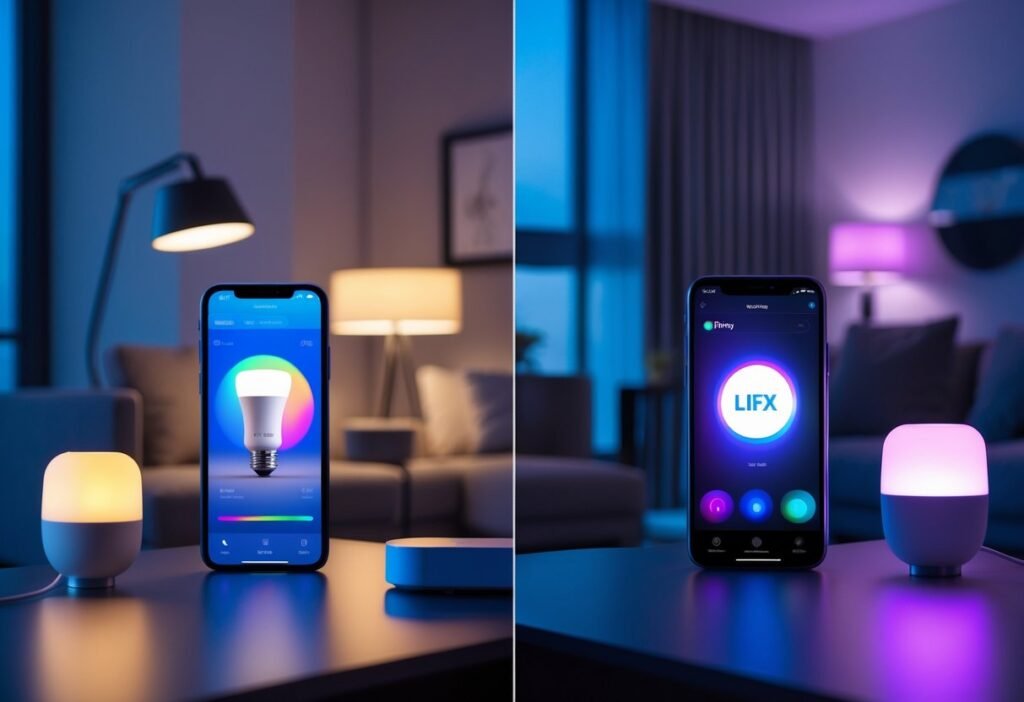
Both Philips Hue and LIFX are heavy hitters in smart lighting, but they’re built on different ideas—especially when it comes to setup, compatibility, and how easy it is to add more bulbs or accessories down the line.
Hub vs Wi-Fi: Setup and Connectivity
Philips Hue bulbs need the Hue Bridge, which plugs into your router. The Bridge uses Zigbee, a wireless protocol that’s low-power and keeps the lights responsive, even if your Wi-Fi’s acting up. It’s great if you want to control a bunch of bulbs at once.
LIFX bulbs connect directly to your Wi-Fi—no hub, no extra boxes. Just screw one in, fire up the LIFX app, and get it on your network. It’s fast and easy, especially if you just want one or two bulbs. The only catch? If your home Wi-Fi is crowded, you might notice the occasional hiccup.
Here’s a quick side-by-side:
| Feature | Philips Hue | LIFX |
|---|---|---|
| Hub required | Yes (Hue Bridge) | No |
| Main connection | Zigbee (via Hub) | Wi-Fi |
| Setup time | A bit longer | Quick |
| Number of bulbs | Good for many | Good for few-many |
Smart Home Integration and Platform Compatibility
Philips Hue is super compatible. It works with Apple HomeKit, Amazon Alexa, Google Assistant, and Samsung SmartThings. The Bridge also lets you set up more advanced automations and use third-party gear like dimmers and motion sensors.
LIFX supports the big voice assistants too: Siri (with HomeKit), Alexa, and Google Assistant. No extra hub needed. It also hooks into IFTTT and some SmartThings features. If you’re planning a big setup with lots of automations, Hue’s Bridge might have the upper hand. But for smaller setups or if you don’t want more hardware, LIFX keeps things simple.
If you want every integration under the sun and maybe a few more gadgets later, Hue’s a safe bet. If you’re after a no-fuss setup, LIFX is probably easier to live with.
Bulb Range, Accessories, and Expandability
Philips Hue has a ton of options—bulbs in all shapes, light strips, lamps, and even outdoor stuff. There are also plenty of accessories like dimmers, switches, buttons, and sensors, which makes it easy to build out your system any way you like.
LIFX mostly sticks with Wi-Fi bulbs and light strips, and there aren’t as many add-ons or switches. Their bulbs are bright and the colors really pop, with a few different shapes to choose from. If you just want straightforward lighting or you’re after the brightest colors, LIFX is great. But if you want to mix and match or get creative with automations, Hue is more flexible.
Performance, Features, and Value Considerations
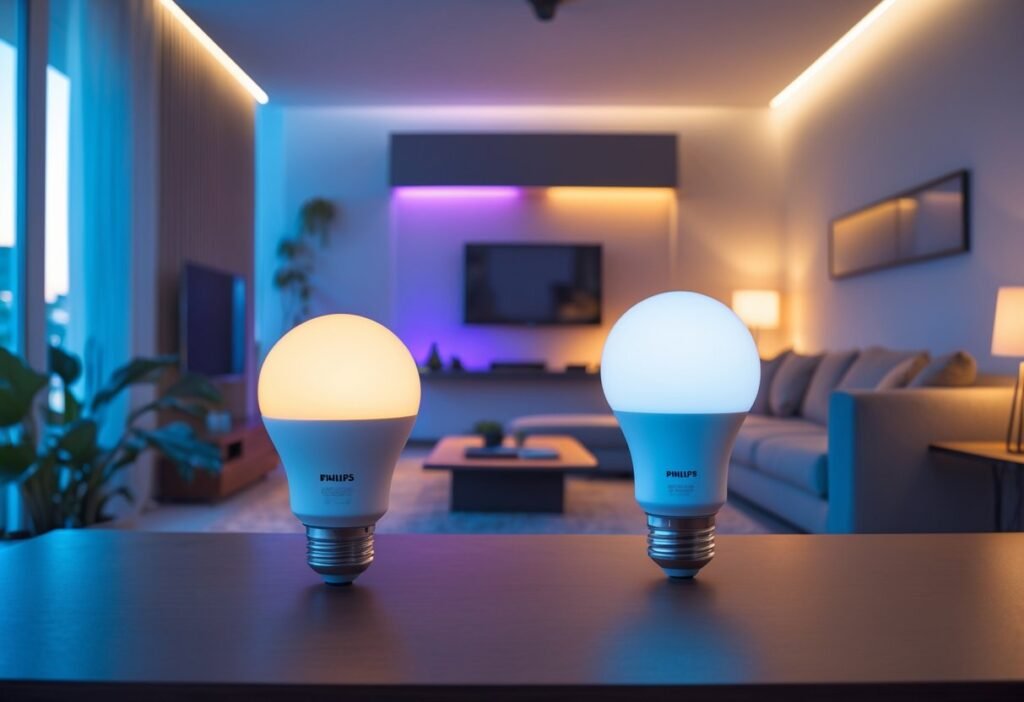
Both Philips Hue and LIFX offer colorful smart lighting, multiple ways to control things, and support for all the big smart home names. But they split on design, setup, and how much you’re paying for the extra features.
Brightness, Color Quality, and Energy Efficiency
Hue bulbs usually put out 800 to 1,600 lumens, from warm to cool whites. LIFX Color Wi-Fi bulbs are in the same ballpark, with some models going up to 1,100 lumens. Both cover millions of colors and light up living rooms, bedrooms, or offices just fine.
Color-wise, both are solid. LIFX bulbs are known for really rich, saturated colors and deeper tones, which is awesome for accent lighting or movie nights. Hue bulbs are reliable with whites and smooth dimming, which comes in handy with their light strips or sensors.
They both use LEDs, so they’re energy efficient. Most bulbs use about 10 watts at full blast and last 20,000 to 25,000 hours. You won’t be replacing them often, and your power bill won’t spike.
Control Options: Apps, Voice, Automations
Philips Hue works through its own app, which lets you set schedules, routines, and group controls. It’s compatible with HomeKit, Alexa, Google Assistant, and you can add smart plugs or sensors. The Bridge opens up remote access and more advanced automations, like syncing lights to sunrise or for security tricks.
LIFX bulbs connect straight to Wi-Fi, so setup is quick. The LIFX app lets you tweak colors, set schedules, and it works with Alexa, Google Assistant, and HomeKit. It also supports IFTTT and other smart home platforms. Both brands let you set up routines, but Hue’s add-ons and Zigbee give it more options for whole-home scenes.
- Multicolor & Auto White: Dimmable 16 million colors and warm to cool whites(2500K-6500K). Set your…
- Drive down energy consumption without losing quality (60 W equivalent). Use timer or schedules to…
- Remote Control: Control your smart light bulb from anywhere with your smartphone using the free Kasa…
Last update on 2025-07-15 / Affiliate links / Images from Amazon Product Advertising API
TP-Link Kasa smart bulbs are a cheaper, simpler pick. They do basic color changes, scheduling, and voice control over Wi-Fi, but don’t offer as many automation features as Hue or LIFX.
Pricing, Longevity, and Budget Alternatives
Philips Hue bulbs usually cost more upfront, mostly because you need the Bridge for all the features. Starter kits with three bulbs and a Bridge are a common way in. LIFX bulbs are sold one at a time and are a bit pricier per bulb, but you skip the extra hardware.
- WHAT’S IN THE BOX – Includes one Hue bridge, one smart button, and three White and Color Ambiance…
- UNLOCK THE FULL POWER OF HUE WITH INCLUDED BRIDGE – Enjoy automations, control from anywhere in the…
- MILLIONS OF COLORS – The White & Color Ambiance range offers both warm-to-cool white and millions of…
Last update on 2025-07-15 / Affiliate links / Images from Amazon Product Advertising API
Both claim lifespans up to 25,000 hours, so you’re set for years. Warranties are pretty similar, though you’ll hear the occasional story about early bulb failures.
- 16 Million DIY Colors: Govee smart light bulbs own millions of color and 54 preset scene modes, you…
- Music Sync: Our smart light bulbs change color and brightness simultaneously when sounds are…
- Smart Control: Govee color changing light bulbs make it possible to control your bulbs with simple…
Last update on 2025-07-15 / Affiliate links / Images from Amazon Product Advertising API
If you’re watching your wallet, TP-Link Kasa and other budget smart bulbs do the basics—standard brightness, decent color temperature, app and voice controls—for less. Just don’t expect the same automation or motion sensor tricks as Hue or LIFX.
Frequently Asked Questions
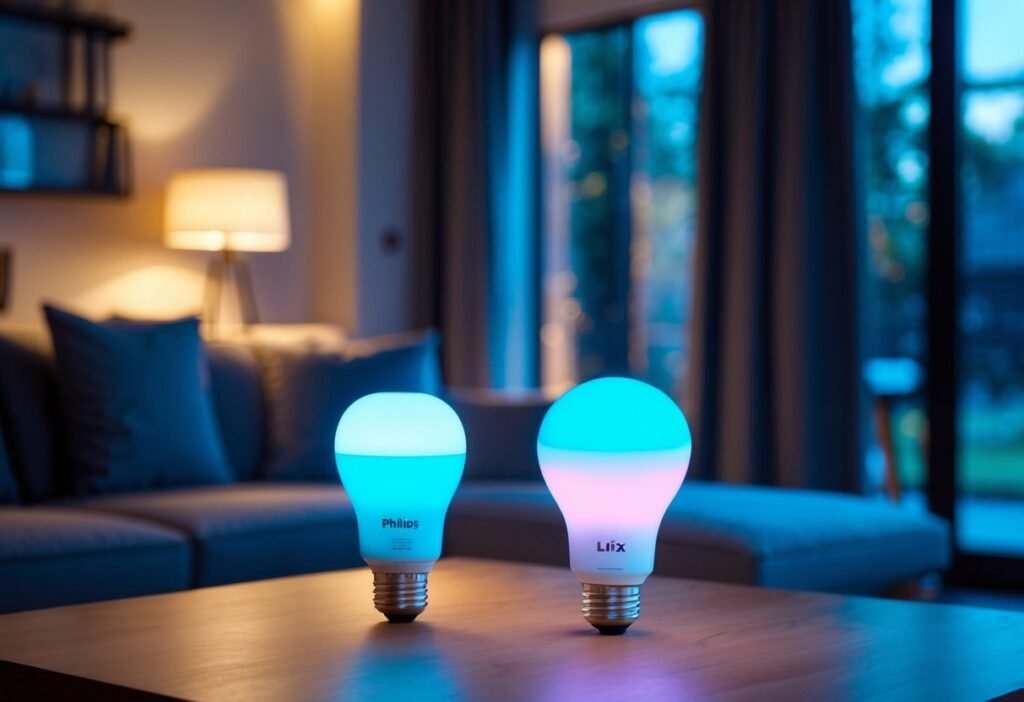
Philips Hue uses a Zigbee-connected hub, while LIFX bulbs just use Wi-Fi and don’t need extra hardware. Both support voice control, have loads of color options, and play well with the main smart assistants.
What are the main differences between Philips Hue and LIFX smart lighting systems?
Philips Hue runs on Zigbee and needs the Hue Bridge for all features and bigger setups. LIFX bulbs connect straight to Wi-Fi—no hub, just the app.
Hue is stable and easy to expand, with lots of accessories. LIFX bulbs are bright and a breeze to set up.
How do Philips Hue and LIFX integrate with smart home ecosystems like Amazon Alexa or Google Home?
Both brands work with Alexa, Google Home, and Apple HomeKit. Hue connects through the Bridge, while LIFX links directly via Wi-Fi and shows up in your smart home app once you connect accounts.
You can use voice commands, schedules, and automations with either.
Can you compare the color accuracy and brightness levels of Philips Hue vs LIFX bulbs?
LIFX bulbs are usually a bit brighter and offer more color options than most Hue bulbs. LIFX supports billions of colors and strong whites, while Hue’s known for reliability and smooth color transitions.
Some people say LIFX colors are more vibrant in certain shades, but honestly, both are great for everyday lighting.
What are the long-term costs associated with Philips Hue and LIFX, considering the initial setup and energy consumption?
Philips Hue costs more at first because of the Bridge. LIFX bulbs are pricier per bulb, but there’s no extra hardware.
Both use energy-efficient LEDs, so electricity costs are about the same. They last for years, and you probably won’t need to replace them very often.
How do the features of Philips Hue’s hub-based system compare to LIFX’s Wi-Fi-based bulbs?
Hue’s hub is great for bigger, complex setups, advanced automations, and keeps things running smoothly even if you have tons of devices. LIFX is better for quick installs or smaller setups since each bulb just uses Wi-Fi.
Both let you set scenes, control lights remotely, and get updates, but Hue’s Bridge can handle a lot more devices at once.
Are there any notable differences in the ease of installation between Philips Hue and LIFX lighting solutions?
LIFX bulbs? Honestly, they’re about as simple as it gets—just screw them in, connect to your Wi-Fi, and use the app. No extra hardware, no fuss.
Philips Hue bulbs also make things pretty easy if you’re just using Bluetooth for a few lights. But if you’re looking to light up your whole place, you’ll need the Hue Bridge, and that means a few more steps. It’s a bit more effort, but you do get more features and, frankly, a more stable setup if you’ve got a ton of bulbs.
Related Posts
Smart Home: Beginner’s Guide to Affordable Home Automation with Budget Devices
Sengled Smart Bulbs Not Responding or Connecting? Here’s the Quick Fix Guide for 2025





